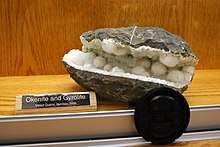Gyrolite
| Gyrolite | |
|---|---|
 Gyrolite | |
| General | |
| Category | Phyllosilicate |
| Formula (repeating unit) | NaCa16(Si23Al)O60(OH)8·14H2O |
| Strunz classification | 9.EE.30 |
| Dana classification | 73.2.2c.1 |
| Crystal system | Triclinic |
| Crystal class |
Pinacoidal (1) (same H-M symbol) |
| Space group | P1 |
| Unit cell |
a = 9.74, b = 9.74 c = 22.4 [Å]; α = 95.71° β = 91.51°, γ = 120.01°; Z = 4 |
| Identification | |
| Color | White, colorless, green, yellow or brown |
| Crystal habit | Compact, lamellar, platy |
| Twinning | Lamellar |
| Cleavage | Perfect on {001} |
| Tenacity | Brittle |
| Mohs scale hardness | 2 1⁄2 |
| Luster | Vitreous, pearly |
| Diaphaneity | Transparent, translucent, opaque |
| Density | 2.45 - 2.51 |
| Optical properties | Biaxial (-) |
| Refractive index | nα = 1.535 nβ = 1.548 nγ = 1.549 |
| Birefringence | δ = 0.0140 |
| References | [1][2][3] |
Gyrolite, NaCa16(Si23Al)O60(OH)8·14H2O,[2] is a rare silicate mineral (basic sodium calcium silicate hydrate: N-C-S-H, in cement chemist notation) belonging to the class of phyllosilicates. Gyrolite is also often associated with zeolites. It is most commonly found as spherical or radial formations in hydrothermally altered basalt and basaltic tuffs.[2] These formations can be glassy, dull or fibrous in appearance.[4]
Gyrolite is also known as centrallasite, glimmer zeolite or gurolite.[2]
Discovery and natural occurrence
It was first described in 1851 for an occurrence at The Storr on the isle of Skye, Scotland and is named from the ancient Greek word for circle, guros (γῦρος), based on the round form in which it is commonly found.[3]
Minerals associated with gyrolite include apophyllite, okenite and many of the mother zeolites.[4] Gyrolite is found in Scotland, Ireland; Italy, Faroe Islands, Greenland, India, Japan, USA, Canada and various other localities.[1][2]
Occurrence in hardened cement paste and concrete
Gyrolite is also mentioned as a rare calcium silicate hydrate (C-S-H) phase in cement chemistry textbooks [5][6] with a simplified formulation: Ca8(Si4O10)3(OH)4 · ~6 H2O, which is consistent with the general formulation given here above, but does not consider the isomorphic substitution of one silicon atom by one aluminum and one sodium atoms in its crystal lattice. Gyrolite may form at higher temperature in oilwell cement muds containing ground granulated blast furnace slags (GGBFS) activated by alkali. It could also form in CEM III cement-based concrete exposed to alkali-silica reaction at elevated temperature.
Hydrothermal synthesis
Gyrolite can be synthesized in the laboratory, or industrially, by hydrothermal reaction in the temperature range 150 – 250 °C by reacting CaO and amorphous SiO2, or quartz, in saturated steam in the presence of CaSO4 salts or not.[7][8] At temperature lower than 150 °C, the reaction rate is very slow. At temperature above 250 °C, gyrolite recrystallizes into 1.13 nm tobermorite and xonotlite.[7] Gyrolite is also one of the rare phases detected in situ along with pectolite by synchrotron X-rays diffraction in hydrothermal synthesis of cement.[9] Synthetic gyrolite has also a large specific surface and could enter industrial applications as oil absorber.[10]
References
- 1 2 Gyrolite in the Handbook of Mineralogy
- 1 2 3 4 5 "Gyrolite".
- 1 2 Dave Barthelmy. "Gyrolite Mineral Data".
- 1 2 "Gyrolite (Hydrated Calcium Silicate Hydroxide)". Galleries.com. Retrieved 2016-02-27.
- ↑ Hewlett, Peter (2003). Lea's chemistry of cement and concrete. See chapter 14.2 Oilwell cement, p. 807. Elsevier. ISBN 0-08-053541-0.
- ↑ Taylor, Harry F.W. (1997). Cement chemistry. See gyrolite at pp. 344 and 348. Thomas Telford. ISBN 0-7277-2592-0.
- 1 2 Siauciunas, R.; Baltakys, K. (2004). "Formation of gyrolite during hydrothermal synthesis in the mixtures of CaO and amorphous SiO2 or quartz". Cement and Concrete Research. 34 (11): 2029–2036. doi:10.1016/j.cemconres.2004.03.009. ISSN 0008-8846.
- ↑ Baltakys, K.; Siauciunas, R. (2010). "Influence of gypsum additive on the gyrolite formation process". Cement and Concrete Research. 40 (3): 376–383. doi:10.1016/j.cemconres.2009.11.004. ISSN 0008-8846.
- ↑ Shawa, S.; Henderson, C. M. B.; Clark, S. M. (2001). "Hydrothermal synthesis of cement phases: An in situ synchrotron, energy dispersive diffraction study of reaction kinetics and mechanisms". High Pressure Research. 20 (1–6): 311–324. doi:10.1080/08957950108206179. ISSN 0895-7959.
- ↑ "Patent application number: 15/034,912. Inventors: Yuuta Tsumura (Naruto-shi), Kazuki Kamai (Naruto-shi), Yukinori Konishi (Naruto-shi), Kazuhiko Tamagawa (Naruto-shi). Powdered gyrolite-type calcium silicate having high oil absorbency and large particle diameter, and production method therefor". Nov 7, 2014.
Further reading
- Anderson Thomas (1851) Description and analysis of gyrolite, a new mineral species. In: The London, Edinburgh, and Dublin Philosophical Magazine and Journal of Science, Vol. 1, 111–113. (PDF 239,5 kB)
- Fleischer M. (1959) New mineral names. In: American Mineralogist, Vol. 44, 464–470 (PDF 444 kB; p. 7: Centrallasite = Gyrolite).
| Wikimedia Commons has media related to Gyrolite. |